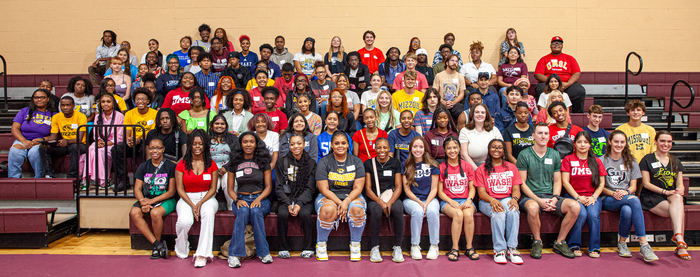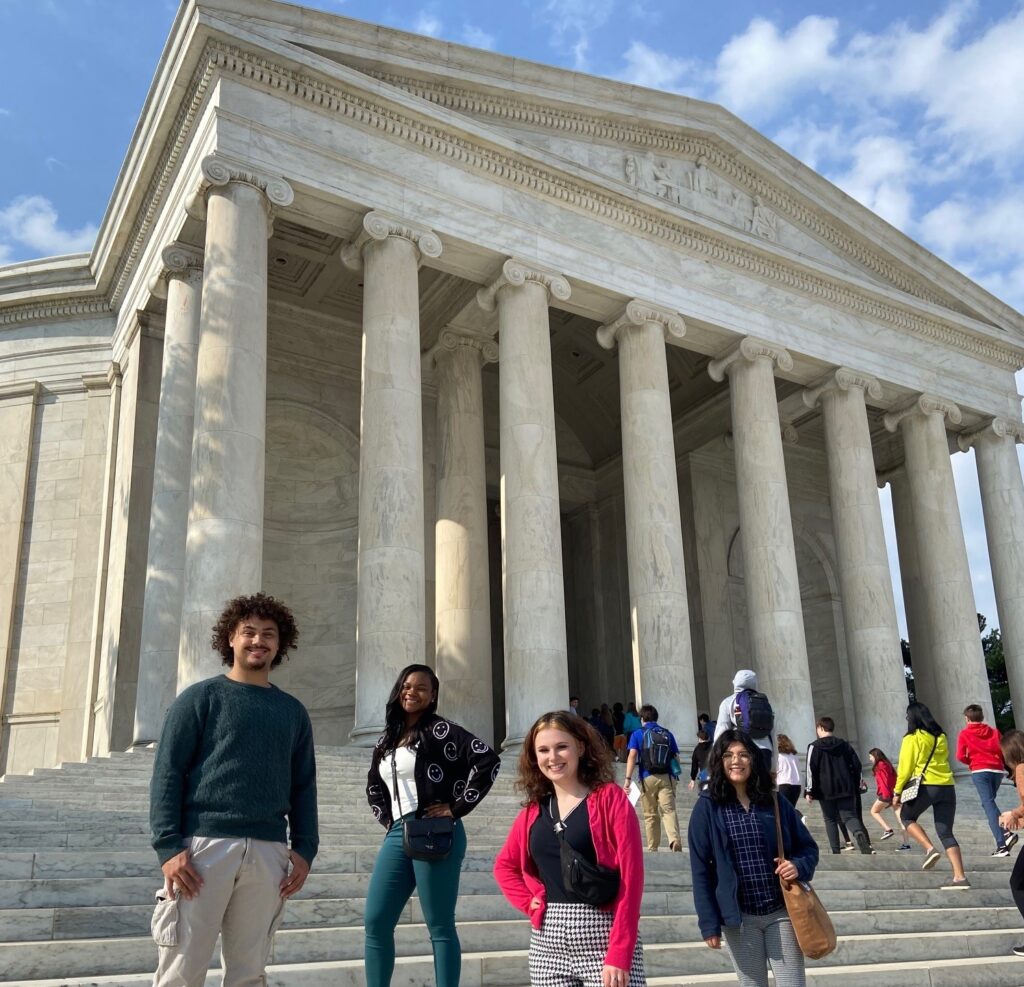
Scholarship Foundation staff gather to discuss “St. Louis in1846” at the St. Louis Art Museum.
Editor’s Note:
Every now and then, the title of this blog is a misnomer because a guest is invited to write. In this post, you will find “words of Jess”. Communications Specialist Jess Dewes has been on staff with The Scholarship Foundation of St. Louis since August, 2022 and she has upgraded social and print media exponentially since. Her prior career included roles in restaurant marketing, professional photography, and teaching studio art at the K-12 level. You’ll recognize these ways of working in her post detailing a recent special staff meeting. Enjoy! – Faith
I am a visual person. Whether it’s oil paintings in a museum or photos on a simple flyer, the way stories are told with images has always interested me. As a kid, I went to the St. Louis Art Museum on a field trip, and I was completely floored by the whole experience. When you think about it, the concept that a whole building can be just about pictures and sculptures, not furniture or school or groceries, is pretty incredible. And it blew my little mind. Since that day, the museum has always been one of my favorite places to get lost and discover images I couldn’t imagine on my own. There, the walls are full of stories…of people, animals, landscapes, wars, love, families, and all the big and little moments that make up humanity…from across the whole world and all the eras. And while everybody sees images a little differently, the process of how people connect to them is what interests me the most.
Professionally, I have explored art, education, and communications in a variety of fields. In my role as Communications Specialist at The Scholarship Foundation of St. Louis, one where so many of my passions come together, I recently had the opportunity to co-facilitate a staff meeting with my colleague, Director of Information Technology, Rob Foley. The topic: visual literacy. Rob and I both deal with visual representation regularly in our work at the Foundation. While my focus is generally on the photography and design aspects of storytelling, Rob communicates important Foundation data and information visually by using graphs and charts. We decided to make it a field trip and the destination choice was an easy one: The St. Louis Art Museum. With the goal of exploring how a group of people interact with and interpret the same image, the staff convened at the museum on a beautiful Friday morning and gathered around one painting for an opportunity to connect with each other.
Facilitating the conversation using the Visual Thinking Strategies model, my role was to keep the observations coming by asking three simple questions of my colleagues:
What’s going on in this picture?
What do you see that makes you say that?
What more can you find?
Twenty minutes flew by as the staff found interesting ways to connect their observations, their perspectives, and their individual experiences both to the painting and to each other. The experience of sharing our views of a common visual subject, without an “expert” opinion, allowed the conversation to unfold in a deep and rich way. The staff made connections between the images in the painting and our city today: a river dividing us, the juxtaposition of old and new technologies, the city as a stopover for folks just passing through. They noticed the lightness and darkness of the spaces, observed the direction the subjects were pointed towards, and compared the river’s bend to what we know it to be now, hemmed in by industry and expansion. Every member of the staff took part in the discussion and the truth that everyone sees the same picture a little differently, based on who they are and what they bring to it, was evident to us all. Together, we considered so much more about the painting, our city, and each other by having spent time together that morning.
Afterwards, we packed up our folding stools and spread out across the museum with an assignment: look for a piece of art that spoke to us about the mission of our work at The Scholarship Foundation. Each staff member submitted a photograph of a work and a few sentences describing why they chose it for the prompt.
Below are just a few of the responses that were submitted that day:
“I chose this painting because it shows people doing “everyday things” nothing extraordinary but still worthy to be noticed and that’s how I want all the students and families we encounter to feel – worthy by simply existing.”
“I connected this with the Foundations’ work to support students in reaching for their education and goals, as well as the support of staff in reaching their full potential and striving to be their best selves, by continuous learning (and unlearning).”
“This piece represents our mission. While there’s focus on the barriers(lines), there is still so much space to design new possibilities.”
“This ceramic jug is one of an estimated 40,000 pieces made by a man named Dave (later taking the last name Drake) who was enslaved in South Carolina from birth in 1801 through most of his life. In the photo, you will see an inscription at the neck of the pot and the fingerprints of the artist at the base (a result of the process of preparing the pot for salt firing in a kiln). Understand this; Dave inscribed his pots with his name and the date and often a saying or verse of his own writing. In South Carolina at the time (and spanning some 100 years) it was against the law for those enslaved to be literate. The documentation on the pedestal makes me suspicious that the museum knew we’d be seated just a few feet away today, since these words reflect well our work and Dave Drake’s work as ‘defiant expressions of literacy, authorship, and creativity.'”
“I chose this piece because of how the subject is posed and placed at the center of the canvas, just as we put students at the center of our work at the Foundation. The subject has a confidence that, to me, is indicative of a person who knows who she is, where she’s from, and exactly where she wants to go. I admire these qualities, among others, in so many of the students of the Scholarship Foundation.”











